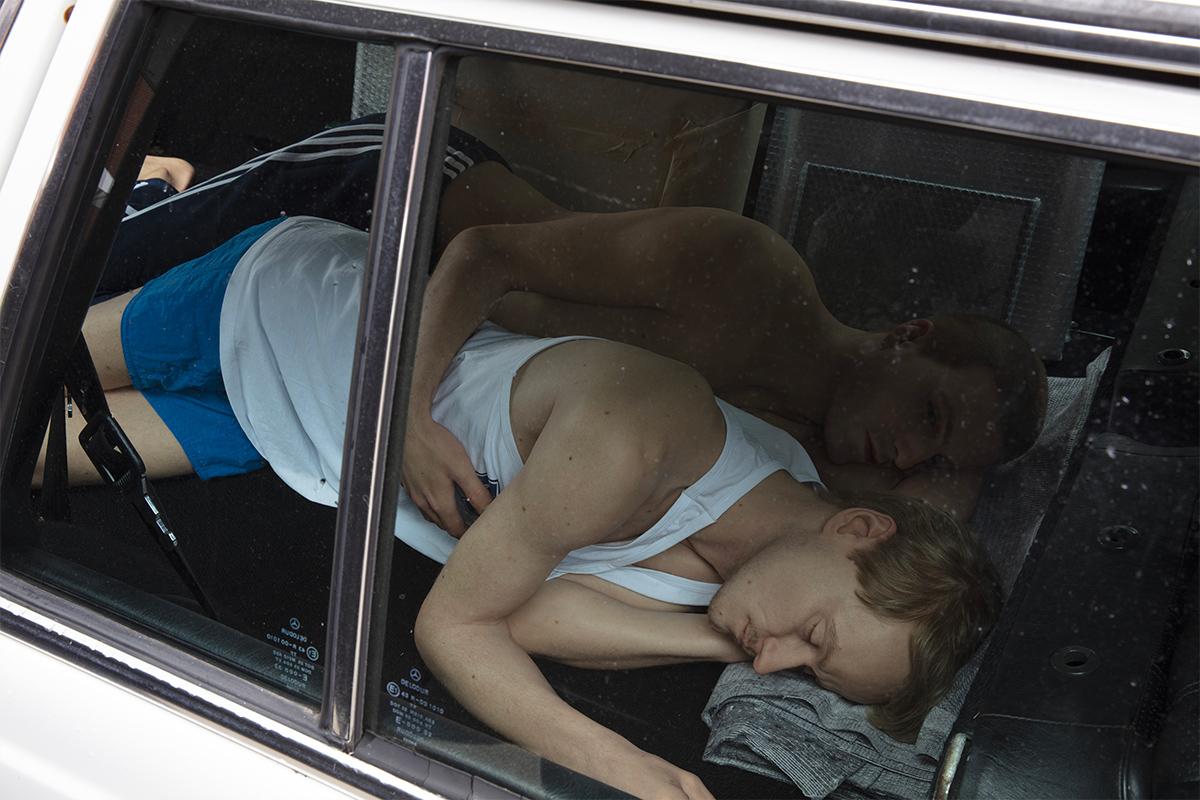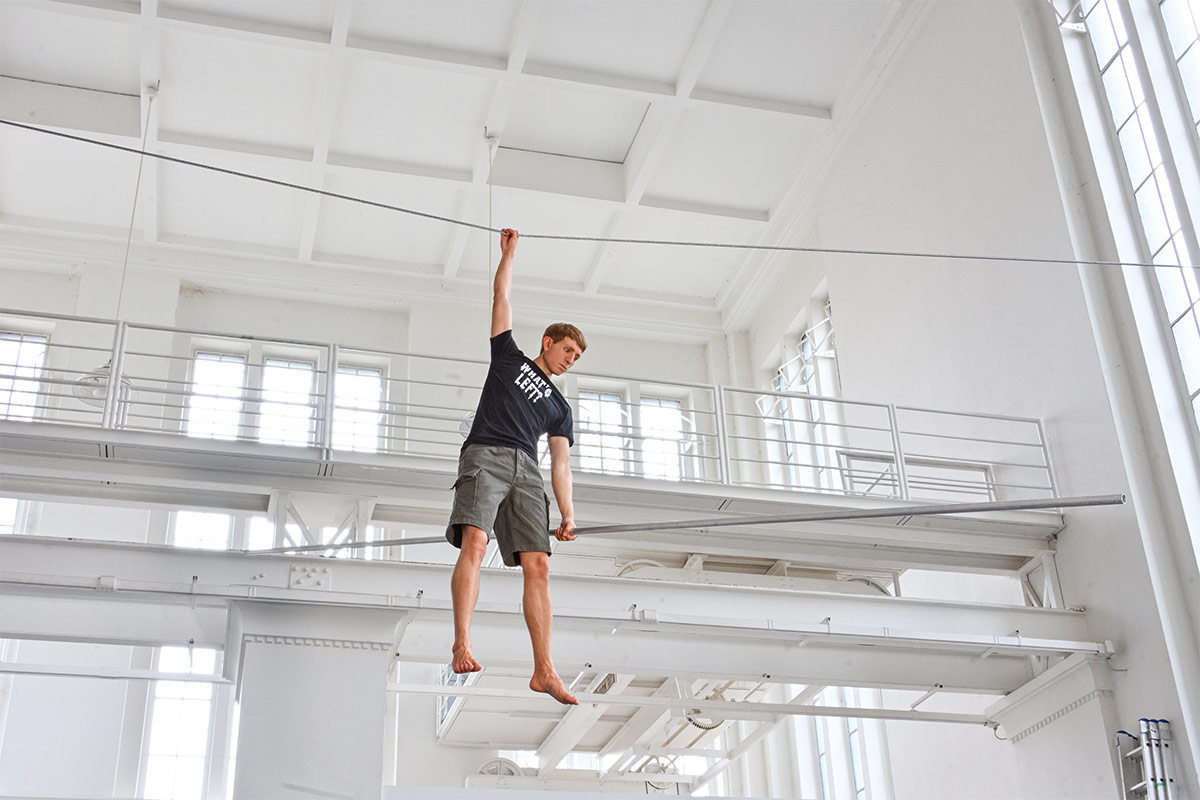Immersive installations and dystopian settings challenge the visitors’ perception of their own bodies and the way they relate with those of others
Lampoon presents Useless Bodies? by Elmgreen & Dragset
Conceived for four gallery spaces and the courtyard of the Milan venue and spanning more than 3,000 square meters, the exhibition Useless Bodies? by the artist duo Elmgreen & Dragset represents one of the most ambitious thematic investigations realized by Fondazione Prada. The exhibit investigates the role and condition of the human body in the post-industrial age in an exploratory way. Our physical presence is losing its centrality. From our working conditions to our health, our interpersonal relationships, and the way we retain information.
«The question mark in the title was born during the writing of the catalog. The artists do not have the claim to make statements. They simply question the potential loss of value of the human body through their direct experience of Western adult men». This is what Niccolò Gravina, curator of Useless Bodies?, explains. Conceived in 2018, before the pandemic, the exhibition has taken on new meanings with the outbreak of Covid-19. This led to an overlap of our physical and digital life.
The increase use of technology
«The increased use of technology means we do not meet or need to meet face to face anymore. This impacts everything. From making our home life more public as a backdrop for work Zooms or social calls, to how we constitute our identities, which now takes place so much online, on social media rather than in real life», the artist duo explains. «The pandemic also taught us that our body can be fragile and dangerous simultaneously. A vehicle of diseases and viruses», Gavina adds.
Following the exhibition path from the Podium, to the Nord gallery, to the Cisterna, the audience will encounter several immersive installations, each with its atmosphere, theme, and aesthetic. «We aimed at creating a whole universe, where visitors can move from one environment to the next, and these environments will, in different ways, all look into particular parts of life. Each space deals with its theme like there are exhibitions within exhibitions.», the artists explain.
The Podium
On the first floor of the Podium of the Milan premises of Fondazione Prada, a series of classical and neoclassical sculptures stand in dialogue with works by the Scandinavian duo, creating a juxtaposition that draws inspiration from the foundation’s inaugural exhibition Serial Classic, curated by Salvatore Settis and designed by Rem Khoolas in 2015.
The comparison pushes the audience to reflect on the similarities and differences in how artists depicted the male body through sculptural practices across different centuries. As pointed out by the curator, the exhibition’s visitors will come face to face with representations of fragile and flawed male bodies and an array of anti-heroes depicting the vulnerability of today’s society.
«Even the choice of the classical sculptures was not accidental. All the statues embody the defeat and fragility of the male body», Gravina explains. Reflection and mirrors, a common theme found not only in the Podium, but also in the other gallery spaces, invite visitors to consider their own bodies and the role they play in society.
Garden of Eden
«The body has become more important in certain fields like tech, while becoming almost obsolete in others, like manual production. It has more or less been re-positioned culturally in almost every field: in the labor market, in our public spaces, in the health and wellness industries, […]. But many of these changes only accelerated by the pandemic. Take the workplace, for example», Elmgreen & Dragset claim.
The second floor of the Podium hosts a large installation by the artist duo called Garden of Eden, a vast, abandoned office landscape that focuses on the body’s changing role in labor. The installation consists of a repetitive pattern of seemingly endless rows of workstations, like an eerie space for human storage and productivity, referencing the geometric formats of 20th-century minimal sculpture.
According to Elmgreen & Dragset, the concept was conceived before the Covid-19 hit. Still, the nature and meaning of the installation were immediately impacted as the environment became a reality for thousands of people suddenly having to work from home.
«This exhibition is full of topics which have preoccupied us throughout our practice. But somehow, by bringing them to the fore and all together, they seemed to make sense in ways we had not necessarily expected». This environment also evokes dystopian movie sets from films such as Jacques Tati’s Playtime (1967) and Terry Gilliam’s Brazil (1985).
The North Gallery
In the North Gallery, visitors are immersed in a dystopian domestic setting halfway between a spaceship and a bunker. This space’s immaculate appearance is emphasized by clinically designed objects deprived of their functionality. In this case, Elmgreen & Dragset aims to raise questions about how we exist in our homes nowadays. And, most importantly, how we share it with technology and its high degree of pervasiveness.
Wandering across the different parts of the dehumanized house, visitors will come across a kitchen without a stove. A table surrounded by chairs without seats, and a robotic dog, the only moving presence in the whole setting.
The most attentive will also notice an architectural plant of a museum hosting it, the plant of a prison: «Museums are often prisons, both for artists and spectators. Elmgreen & Dragset want to communicate the urgency of making the museum institution a place for dialogue and comparison. Therefore, in this regard, the question mark in the title is more than welcome», Gravina claims.
The Cisterna and the courtyard
It features an abandoned swimming pool and a locker room in three rooms that resemble a forsaken spa. «These installations speak about how the health and wellness industries promote and demand new body ideals and depict some of the few spaces where people meet and maybe undress or can be at leisure around others», the artists explain.
The central room of the Cisterna features a new work titled What’s Left?, a young man hanging on a wire which crosses the room from one wall to the other, holding in his left hand a long grey pole. In essence, the work is a representation of a body struggling to find its role as a political actor or instrument of social change.
The investigation of Elmgreen & Dragset addresses the recent changes in the perception of the human body concerning gender and sexuality, politics, and the way people communicate with one another. Near the entrance of the Tower, visitors will encounter another sculptural work consisting of a car in which a couple of young men embracing each other– apparently two workers from the art world – is resting surrounded by several packaged works of art. The car, carrying a Russian license plate, is an apparent reference to the difficulties the Russian LGBTQIA+ community faces in the current national political context.
Elmgreen & Dragset – The topic of the human body
«We started using our bodies in performances at the beginning of our collaboration, in the 90s. Our focus was first on our own two bodies. Then it grew to look at our physical relationships with objects and spaces in a broader sense and then into figurative sculptures in the early 2000s.», the artist duo says about their fascination with the human body.
Although the topic of the human body and its relationship with the outside has played a key role in most of their works since the beginning of their practice. For instance, by engaging the audience as co-performer or co-author of their performances and immersive installations. The artists recognized the body for the first time as a separate theme.
Challenging the way truths and information are now delivered through bite-sized Facebook posts and striking headlines, Useless Bodies? the artist duo aims to allow the audience to go beyond everyday life routines. And also contemplate and think about the world in a non-binary way.
«To question and pursue the information we are given is empowering, and art can be a liberating force in this way, especially in times of so much fear as those we live in now. We hope that art can lessen people’s fear or concerns», Elmgreen & Dragset explain.
Acknowledging people’s eagerness to experience things in real life and be around others’ bodies. Especially in a time when the body faces marginalization in many fields of life, the artists find art a means of escape from reality. And also a suitable way to foster communities and togetherness.
Elmgreen and Dragset
Michael Elmgreen (born 1961 in Copenhagen, Denmark) and Ingar Dragset (born 1969 in Trondheim, Norway) are based in Berlin. They have worked together as an artist duo since 1995. Elmgreen and Dragset have held numerous solo exhibitions at art institutions worldwide. Samsung Museum of Art, Seoul (2015); Victoria and Albert Museum, London (2013–14); Tate Modern, London (2004); and Kunsthalle Zürich (2001), among others.
Useless Bodies? will be on show until 22 August 2022.




















